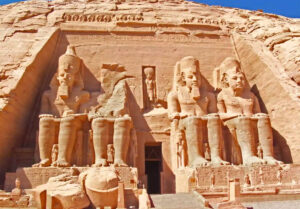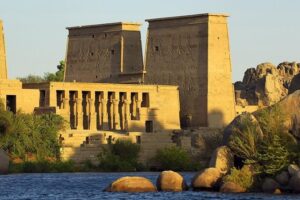The Divine Rulers of Ancient Egypt
The title pharaoh was given to the divine monarchs of ancient Egypt. The term originally meant “Great House” and referred to the royal palace. Later, during the New Kingdom, the title came to signify the king himself. Pharaohs were more than political leaders; Egyptians considered them living gods on Earth. They were the divine link between humanity and the gods. The people believed the gods gave pharaohs their absolute authority. This gave them complete control over the land, people, and religious life of the nation.
The Pharaoh’s Role and Responsibilities
The pharaoh’s primary responsibility was to maintain maat, a concept representing truth, justice, and cosmic order. This was a heavy burden, as people believed the pharaoh was the only person who could guarantee the annual flooding of the Nile, a vital event for agricultural prosperity. To maintain maat, the pharaoh performed daily rituals, presided over religious ceremonies, and constructed temples to honor the gods.
In addition to their religious duties, pharaohs were also the chief administrators of Egypt. They commanded the military, enacted laws, oversaw the economy, and managed vast public works projects, including the construction of their own monumental tombs. They were supported by a complex bureaucracy of officials, scribes, and priests who helped manage the day-to-day affairs of the kingdom.
The Symbols of Power
The pharaoh’s divinity and authority were expressed through a variety of powerful symbols. The most important was the double crown (the pschent), which combined the white crown of Upper Egypt and the red crown of Lower Egypt, symbolizing the pharaoh’s rule over a unified kingdom. Other key symbols included the false beard, a braided beard worn on the chin that was a symbol of divine kingship; the uraeus, a cobra emblem worn on the headdress that represented the protection of the goddess Wadjet; and the crook and flail, symbols of kingship and divine authority.
Notable Pharaohs
Throughout Egypt’s long and complex history, many pharaohs left an indelible mark on the nation. Their reigns shaped culture, religion, and politics for centuries.
Djoser (c. 2670 BCE)
As the first pharaoh of the Third Dynasty, Djoser is a monumental figure in Egyptian history. He is most famous for commissioning the Step Pyramid at Saqqara, a revolutionary structure that stands as the world’s first large-scale stone building. This project not only introduced a new architectural style but also set the standard for the grand tombs of future pharaohs.
Khufu (c. 2589-2566 BCE)
Next, we look at Khufu, a pharaoh of the Fourth Dynasty. He commands a lasting legacy for building the Great Pyramid of Giza, which remains the largest pyramid ever constructed. This incredible structure stands as a testament to the organizational power and immense resources of the Old Kingdom.
Hatshepsut (c. 1479-1458 BCE)
Moving forward in time, Hatshepsut was a unique and powerful female pharaoh of the Eighteenth Dynasty. She ruled for over two decades, a remarkable feat for a woman in ancient Egypt. During her peaceful reign, she oversaw a period of great economic prosperity, commissioning magnificent monuments and expanding lucrative trade routes, most notably to the land of Punt.
Akhenaten (c. 1353-1336 BCE)
By contrast, Akhenaten, also of the Eighteenth Dynasty, was one of the most controversial pharaohs. He radically changed Egypt’s religious landscape by abandoning its traditional polytheistic beliefs in favor of worshipping a single deity, the sun god Aten. He even moved the capital to a new city, Amarna, and instigated a profound and short-lived change in art and religion.
Tutankhamun (c. 1332-1323 BCE)
Tutankhamun, Akhenaten’s successor, is famously known as the “Boy King” due to his very young age when he ascended the throne. Although his reign was short and largely spent reversing his father’s religious reforms, the discovery of his nearly intact tomb in 1922 provided an unprecedented glimpse into the wealth, art, and daily life of the New Kingdom.
Ramesses II (c. 1279-1213 BCE)
Finally, we have Ramesses II, often called Ramesses the Great. He was one of the most powerful and long-reigning pharaohs of the Nineteenth Dynasty. His reign was defined by military prowess, as he led numerous campaigns, and diplomatic success, culminating in the signing of the world’s first known peace treaty with the Hittites. Furthermore, he was a prolific builder, constructing monumental temples such as Abu Simbel.
The Pharaohs in Death
Death was not the end for a pharaoh; it was a transition to the afterlife. The Egyptians believed the pharaoh’s spirit, or ka, would continue to guide the people from the land of the dead. To ensure a successful journey, the pharaoh’s body was carefully mummified and entombed in a magnificent tomb, such as a pyramid or a rock-cut tomb in the Valley of the Kings. We found a fortune of treasures, furniture, and all the necessities for the pharaoh’s eternal existence in the tombs. The grandeur of these tombs was a final, powerful testament to the pharaoh’s divine status and lasting importance.
Before you go to Egypt, check the weather and contact us for your trips.











